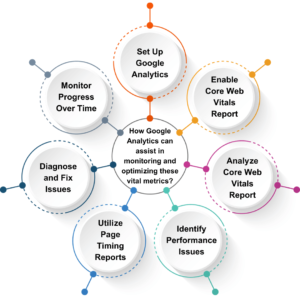A fast and user-friendly website is crucial for online success. Google recognizes the importance of user experience and has introduced Core Web Vitals, a set of performance metrics that measure various aspects of website speed, responsiveness, and visual stability. To help website owners monitor and improve these metrics, Google Analytics provides valuable insights and tools. In this guide, we’ll explore how to leverage Google Analytics for monitoring Core Web Vitals and optimizing your website’s performance.
How can Google Analytics assist in monitoring and optimizing these vital metrics?

Step 1: Set Up Google Analytics:
If you haven’t already, create a Google Analytics account and integrate the tracking code into your website. This will enable you to collect data and access insightful reports related to your website’s performance.
Step 2: Enable Core Web Vitals Report:
Once your Google Analytics account is set up, enable the Core Web Vitals report. This report provides a consolidated view of your website’s performance based on Core Web Vitals metrics.
Step 3: Analyze Core Web Vitals Report:
Navigate to the Core Web Vitals report in Google Analytics to gain valuable insights into how your website is performing. This report will highlight areas that require improvement to enhance user experience.
Step 4: Identify Performance Issues:
Within the Core Web Vitals report, identify specific pages or areas of your website that have poor performance scores. Focus on pages with high traffic or those that contribute significantly to your business goals.
Step 5: Utilize Page Timing Reports:
Google Analytics offers additional reports, such as the Page Timings report, which provides detailed information about page load times. Identify pages with slower loading times and prioritize optimizing them to improve LCP.
Step 6: Diagnose and Fix Issues:
To diagnose and address issues affecting Core Web Vitals, use Google’s PageSpeed Insights tool. This tool analyzes your webpages and offers recommendations to enhance performance. Implement suggested improvements to enhance LCP, FID, and CLS scores.
Step 7: Monitor Progress Over Time:
Continuously monitor your website’s performance using Google Analytics. Track changes in Core Web Vitals metrics to assess the effectiveness of optimizations made. Regularly reviewing reports will help you identify new issues and ensure your website maintains optimal performance.
Google Analytics is a powerful tool that provides valuable insights into your website’s performance, including Core Web Vitals metrics. By effectively leveraging Google Analytics, you can monitor, diagnose, and optimize your website to deliver an exceptional user experience. Regularly tracking Core Web Vitals and implementing improvements based on the data will help your website thrive in today’s competitive online landscape. With Google Analytics as your ally, you can stay ahead of the curve and provide a fast, responsive, and visually stable website to your visitors.
Optimize your website’s Core Web Vitals and boost its performance – contact us now!







